In continuation with our beautiful stuff project, the children used real wood piece to create home, buildings, bridges and other various structures. The children created, draw their designs, labelled some parts, glued and painted their designs. It was a great and fun experience.
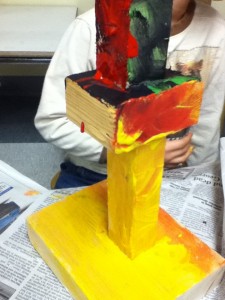
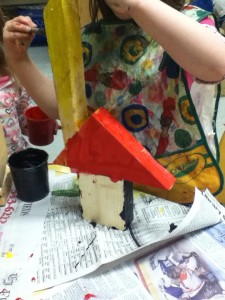
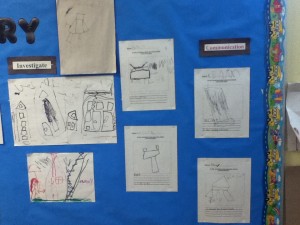
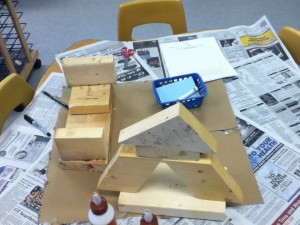
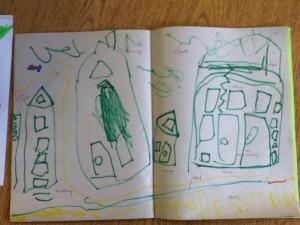 This student independently drew a picture of his neighbourhood when we were writing in our journals. He carefully selected shapes that are parts of a building, told me about the buildings-some stores and houses and added stairs that go to the bed on the top floor (blueprints show stairs!).
This student independently drew a picture of his neighbourhood when we were writing in our journals. He carefully selected shapes that are parts of a building, told me about the buildings-some stores and houses and added stairs that go to the bed on the top floor (blueprints show stairs!).
The emphasis on play-based and inquiry-based learning in the FDK program has profound implications on learning outcomes throughout a child’s academic career. Here are several links to supporting play in the early years. http://earlylearningcentral.ca/?page_id=1192
The program has evolved with the introduction of FDK. Educators are more facilitators, listening to the children’s ideas for exploration (the emerging curriculum), placing materials out that are more exploratory–that provoke questioning and research to find out answers. When children are engaged during play time many skills are developing including reading and writing. Oral language is a huge premise in the entire program. Talking is most critical! Getting children to talk and model appropriate language is the foundation. http://earlylearningcentral.ca/wp-content/uploads/2009/02/literacy-30-used-mar-4.pdf . Here are some great prompts and questions to get you thinking about how to assess oral language and some self-reflective questions about the program in your classroom.
Initially in the school year rules and routines are established that need to be followed both in and out of the classroom. Some children have not been expose to a structured routine/environment at this point in their life and it may take sometime to get them to know the expectations. As they enter opportunities at various point in the classroom the ability to problem-solve, get along with others, share toys, ask for support is all part of self-regulation that will be needed for grade 1 and up and for the rest of their lives.
The two year play-based program provides children time to hone those skills necessary for life. When they enter the block centre or dramatic play they set their own rules and self-monitor how roles should play out. It is at this point they will have to regulate what appropriate behaviours (within the paramaters) are acceptable–they need to talk out disagreements using problem-solving skills, they need to share and/or take turns, ask for help when needed, and adapt to various situations in the day. Within the program the Educators model appropriate behaviours (some boards may follow programs like Second Steps to support), and provide ample opportunities for children to work on self-regulation at different points throughout the day.
In my experience it does take some time for many of the children to acquire these skills. They need to have a firm base of appropriate behaviours before they move up the grades. In my opinion when children don’t know how to self-regulate they take on less desirable behaviours and find themselves in trouble. In the K program it is important to build in the leadership skills by giving them roles and responsibilities, make them feel valued, and allow them to make good/positive choices. The structure of the program then changes are they move to grade 1 where they are expected to sit long for lessons, often more large group teaching occurs, and pencil/paper tasks are required for learning. I am a believer that the inquiry model is appropriate for all grades due to the fact that many skill sets can be acquired with a more emergent curriculum model. Having taught in all primary grades there are some great opportunities to apply the inquiry model into social studies, science where we can apply math and literacy skills and meet the curriculum expectations.
The New Learner:
When children leave the K program they are learning to be independent thinkers, ask questions, apply learning and ideas into different contexts–link the concepts into new situations, have a firm base on printing, basic math concepts, reading readiness skills, have the ability to appropriately problem solve, and understand rules and routines in a structure environment.
Our snow inquiry started from reading a book called Sadie and the Snowman. We used the story over 5 days to focus on retell. Day 1-discussed the pictures and read the story. Day 2- Discussed Characters, Day 3- Setting and a KWL chart was created connecting our own experiences with snow , Day 4 focused on the events, and Day 5 we reviewed all story elements and recreated the scenes with cutouts in large group.
This story not only began the discussion of snow, but hot and cold, the fridge vs the freezer, experimenting with different ice cubes wrapped in various materials like newspapers, foil, paper, and with salt (Which melts faster?) and we tried attaching ice cubes to string using salt. Throughout these experiments children learned new vocabulary, used a thermometer to record temperature, and they observed water changing from a liquid to a solid, they recorded time and charted change.
Throughout this approximate 6 week inquiry on snow, the children communicated their learning in written and visual form to include in their documentation books. It allowed us to explore many new things and the children had so much fun.
This is a monograph about getting started with inquiry. There is a list on the last page that gives 6 tips on how to get started with inquiry http://www.edu.gov.on.ca/eng/literacynumeracy/inspire/research/CBS_StudentInquiry.pdf
This great line….
Today I had an opportunity to read through some research on why documentation is important to student learning. In the attached article http://www.edu.gov.on.ca/eng/literacynumeracy/inspire/research/CBS_Pedagogical.pdf there is some great reference points about how students learn and think and how we as teachers extend our understanding of documentation as we discuss, share and collaborate with colleagues. Another topic that was interesting was peer feedback. I tried this informally late last year and when I felt they were ready. I also tried a form of strengths and next steps (one star, one wish) in my literacy assessment. It was a great opportunity to have a conversation about the student work. Again, I did this in late February. I was amazed at how they were able to share not only what they are good at, but where they need to improve!!
Another important part that stood out the most for me was the accountability. We are constantly defending the play-based learning approach to parents, the public and what better way to display learning through prompts, pictures, and questioning. Display student work with their dialogue, questioning. Have their portfolios out and accessible for them to refer back to, display learning over time–history from previous years. Create a communication board on inquiry and show students engaged in learning! Have a read and enjoy!
Here is a link to some video resources on : Flow of the Day, Inquiry, Observation & Documentation, Play-based Learning, Self-regulation, the Learning Environment, Literacy Throughout the Day and Numeracy Throughout the Day. http://www.edugains.ca/newsite/fulldaykinder/videoa.html


Recent Comments